As well as mentioning a couple of events that are due to happen over the next couple of weeks, I shall be reporting on Robert Baldwin’s talk this week, with a brief note about the earlier Gender and Medieval Studies conference in Swansea.
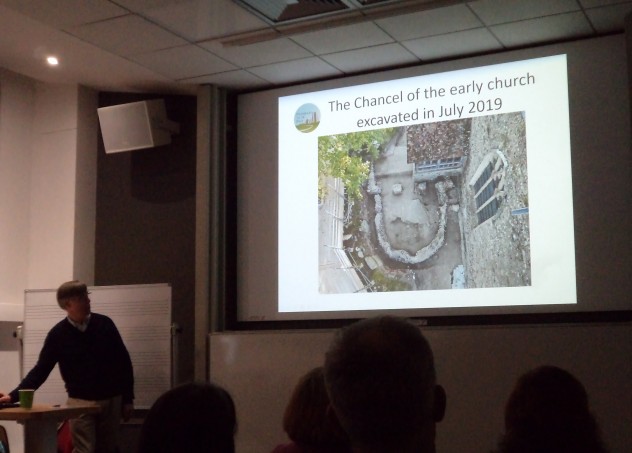
To begin with the new items, next week will be the first meeting of the Kent History Postgraduates group and to confirm Dean Irwin will be giving us his presentation from a conference in Jerusalem over Christmas, while after that we will explore the late medieval Gough Map, concentrating on Kent. Then the week after Dean is again busy on Monday 27 January as one of the organisers of events at Canterbury Cathedral to mark Holocaust Memorial Day. As he says, this commemoration is particularly significant in 2020 because the 27 January will be the 75th Anniversary of the Liberation of Auschwitz. The theme this year is “Standing Together”, and the organisers are seeking to draw as many people as possible from a range of different communities to mark this important event. Among the activities that will take place is a presentation by Sixth Formers from Simon Langton about their work for Holocaust Memorial Day, a guided walk around ‘Jewish Canterbury’ and an exhibition in the Cathedral Archives, both of the latter involving Dean, to be followed by Choral Evensong of Remembrance and Prayer – “Standing Together”. If you are interested in attending and want a programme, please contact the Cathedral Archives.
Later that week on Wednesday 29 January, the first group of CCCU postgraduates from the Taught Masters programmes in Medieval & Early Modern Studies and Modern History will graduate in Canterbury Cathedral. As some of you may remember students from both cohorts were involved in putting on a small exhibition on aspects of Canterbury’s history last summer: https://blogs.canterbury.ac.uk/kenthistory/celebrating-canterbury-history-exhibition-by-cccu-masters-students/
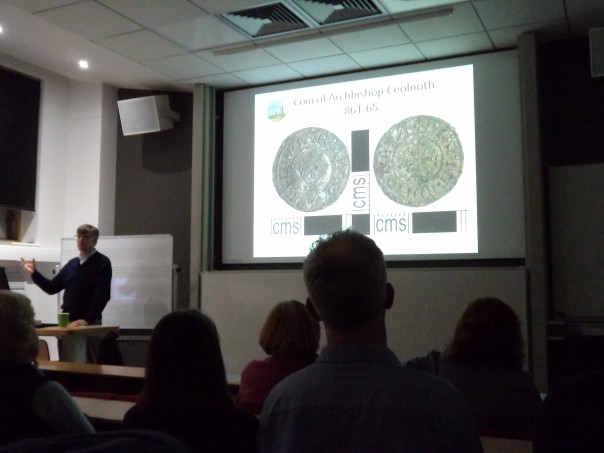
As I reported recently Lawrence Lyle MBE died last month and having attended his funeral in Canterbury Cathedral this week, a moving and beautifully-crafted service that included a detailed and well-judged tribute by Professor Paul Bennett (CAT and CCCU), we at the Centre think it would be wholly appropriate to initiate a postgraduate history prize in his name. Consequently, the postgraduate student with the highest dissertation mark across the two cohorts of students will be awarded the Lawrence Lyle Memorial Postgraduate Prize. I am waiting to hear who will receive the first of these prizes and hope to bring you a photo of him/her at graduation in a couple of weeks.
Now to turn to other matters, I thought I would begin by reporting very briefly on the Gender and Medieval Studies conference in Swansea. These annual, itinerant conferences engage with wide-ranging themes and this year it was ‘Gender, Science and the ‘Natural’ World’. Among the various strands was one on ‘monsters, hybrids and the supernatural’ that Dr Diane Heath contributed to using her work on medieval perceptions surrounding the oyster. Diane will be speaking on the same topic again in the final History Research seminar at CCCU later this term. Thus today, I’ll just say that she was exploring the medieval idea of the ‘wandering womb’, a medical condition that people believed in from classical times until the early modern period, in relation to the oyster and to Marian symbolism. Others at the conference similarly examined ideas about the ‘wandering womb’, including Lucy Allen’s discussion on the crystal as the ‘unnatural womb’ of the Virgin Mary and Vicki Blud’s thoughts on werewolves in late medieval romances as wandering wombs.
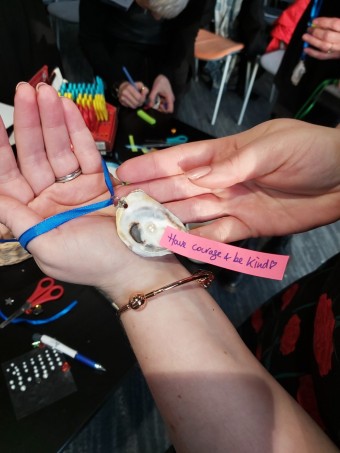
Diane did not confine her presentation to the actual session, and she was joined afterwards by many of the conference delegates to make ‘pearls of wisdom’ using oyster shells, an activity we have used on several occasions as part of the Medieval Pageant in Canterbury and at the ‘Young Medievalist’ days during the Medieval Faversham exhibition to name but a few. And, as Diane can report, making these is as much fun for adults as it is for primary school children!
Last night was the first lecture this term organised jointly by the Centre and FCAT and a very full lecture theatre of students, staff, Friends and members of the public were treated to a fascinating discussion by Robert Baldwin about the Lyminge community archaeological project ‘Pathways to the Past – Exploring the Legacy of Ethelburga’. The idea behind the project was to test the results and conclusions drawn by the antiquarian, amateur archaeologist and former rector Canon Robert Jenkins, who had spent much of his incumbency at the church between 1854 and 1896 digging around the church and presenting his findings on what he believed was an early, large (with 3 eastern apses) Anglo-Saxon church. As well as re-investigating the archaeological excavations, the project is seeking to offer better access to the war memorial in the cemetery extension and provide disabled access to the church by making the main entrance the north porch rather than the main previously used south porch.
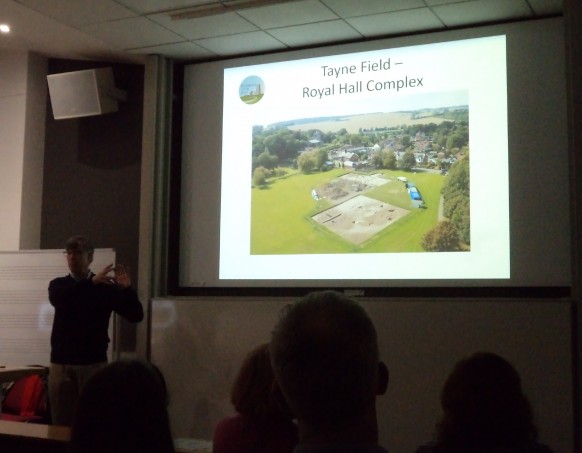
Robert Baldwin is running the project and last summer, as readers of the blog may remember, there was a report about a group visit to the dig where we heard from Rob and Gabor Thomas (University of Reading) https://blogs.canterbury.ac.uk/kenthistory/kentish-saints-using-archaeology-texts-and-material-culture/ . Gabor has been working in Lyminge for over a decade, having found a great mid-Anglo-Saxon royal hall complex in Tayne Field, as well as evidence of the slightly later monastic complex nearby, both of which are close to the village centre and not far from the church.
Canon Jenkins had been keen to find the tomb of St Ethelburga that he believed must be there and having uncovered ‘her’ church, he was keen to display the ruins he had discovered, and the site was not back-filled and proper paths made until 1929. Consequently, as well as the post-1929 paths, Rob and his team had to remove other materials Canon Jenkins had installed to display the ruins, including his use of Portland cement and Victorian brickwork deploying Roman bricks presumably found by Jenkins’ workmen on site. Unpicking this Anglo-Saxon and Victorian jigsaw has been challenging for Gabor, Rob and the team but they now think they have a much better understanding of the size and layout of the original church, the quality of the stone work, and the likelihood that the masons were from Frankia where such sophisticated construction skills were still known in the mid 7th century.
Regarding the building materials, probably the two most important features are the high-quality, very fine mortar used in the earliest parts at the east end, for example. This was made from crushed Roman brick and Rob is hoping that, if the project can raise the necessary money, this can be tested to provide the team with a date (the mortar contains organic matter in the form of sea shells). Even though flint is the major building stone, the excavation team found two column fragments of Marquise stone, which means it is conceivable that the church was not dissimilar to that at Reculver. Two columns from the now lost Anglo-Saxon Reculver church are in the undercroft at Canterbury Cathedral if you want to see what Rob was talking about. Furthermore, even though all the masonry found in the excavation relates to the foundations rather than the church’s superstructure, the site presumably becoming a builders yard considering the Norman church is right next to it, Rob thinks it is possible that the reuse of Roman materials in the mortar meant that the early church builders had employed the Roman ruins at Portus Lemanis as their stone quarry. Such reuse and then further reuse are fascinating and, of course, did not stop with the Anglo-Saxons and Normans, the monastic establishments in the 16th century equally becoming quarries following the dissolution of the monasteries.
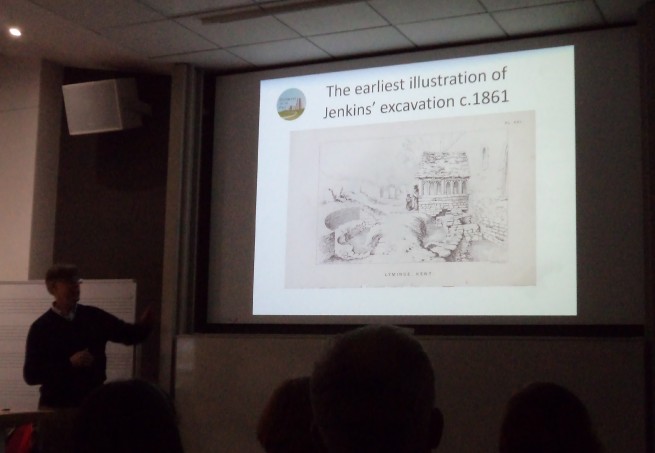
As you can imagine, Rob’s discussion of this re-excavation of Jenkin’s dig and his interpretation was fascinating, not least because in addition to the church, and the likely archiepiscopal residence in the war memorial area, there is the possibility that the team may have found the position of a royal burial in a potential north porticus. Now, of course, it could have been that of St Ethelburga, but she is not the only royal female Anglo-Saxon saint associated with Lyminge. Whether documentary records will help here is still difficult to know. However, there is a manuscript in Hereford Cathedral Library detailing the miracles of St Edburga who was abbess at Minster-in-Thanet, but whose relics were said to have been taken to Lyminge and later moved again to Canterbury. Having looked at this a bit from the Canterbury end, I’ll just add this: S. Sweetinburgh, ‘Anglo-Saxon saints and a Norman archbishop: “Imaginative Memory” and institutional identity at St Gregory’s Priory, Canterbury’, in The Regular Canons in the Medieval British Isles, ed. J. Burton and K. Stober (Turnhout, 2011).
Rob had obviously sparked his audience’s interest and he answered a whole barrage of questions after the lecture. Indeed, there were still people wanting to talk to him afterwards and if this has sparked your interest too, this is the project’s web site: https://geopaethas.com/
 Centre for Kent History and Heritage
Centre for Kent History and Heritage Sheila Sweetinburgh
Sheila Sweetinburgh 1234
1234

